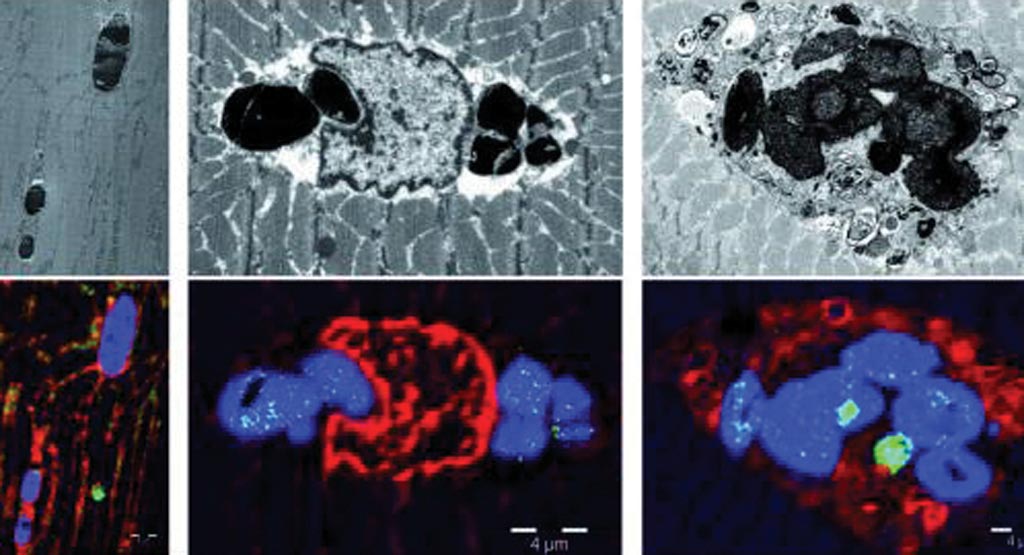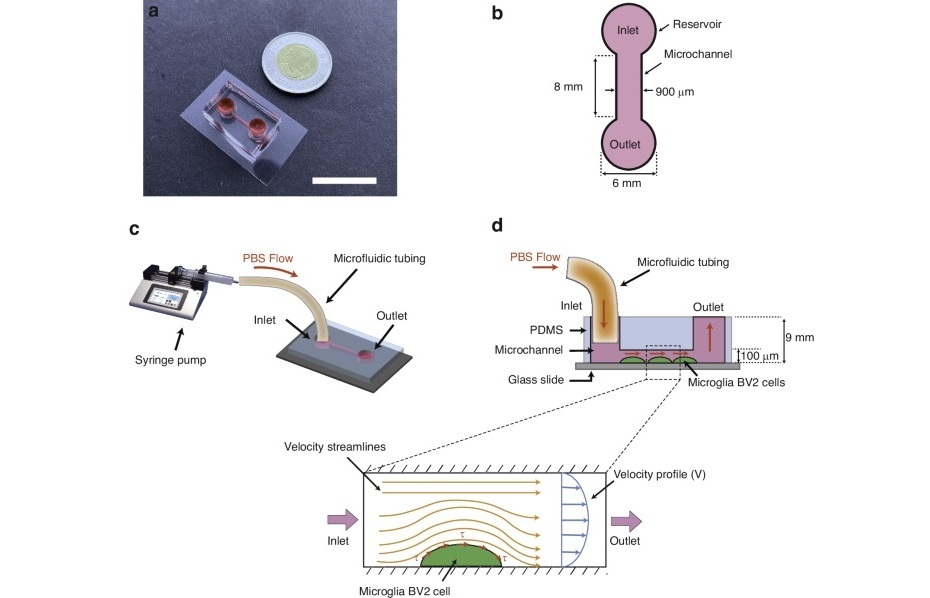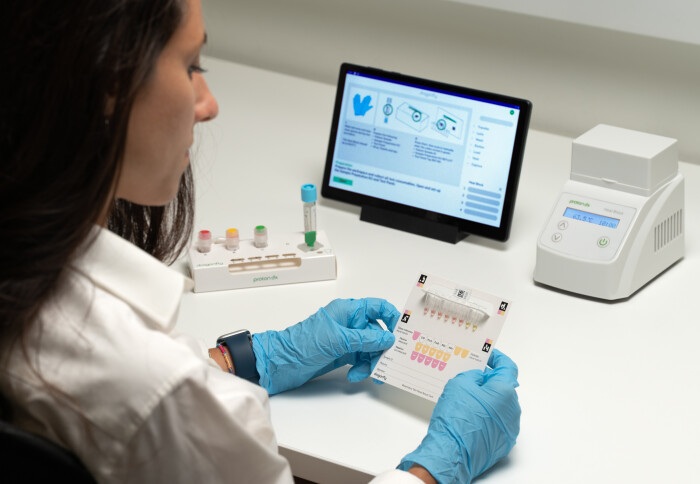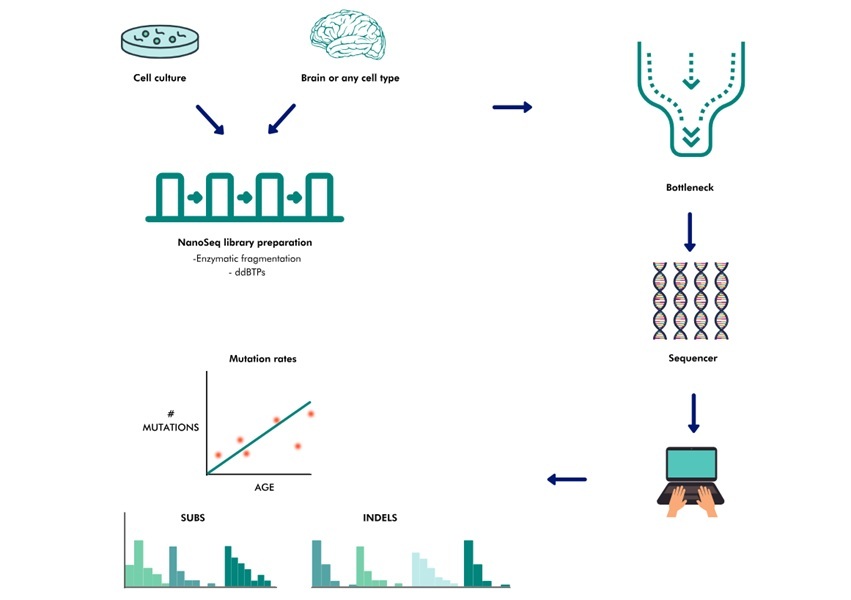Myoglobin Gene Mutation Causes New Muscle Disease
|
By LabMedica International staff writers Posted on 08 Apr 2019 |

Image: Photomicrographs of tissues from patients with myoglobinopathy, a new muscular disease caused by a mutation in the myoglobin gene (Photo courtesy of Bellvitge Biomedical Research Institute).
The cause of myoglobinopathy, a newly described disease of the muscles, has been traced to a mutation in the gene that encodes for the protein myoglobin (MB).
Myoglobin, like hemoglobin (Hb), is a cytoplasmic protein that binds oxygen on a heme group. It harbors only one heme group, whereas hemoglobin has four. Although its heme group is identical to those in Hb, MB has a higher affinity for oxygen than does hemoglobin. This difference is related to its different role: whereas hemoglobin transports oxygen, myoglobin's function is to store oxygen. MB also acts as scavenger of free radicals and other reactive oxygen species, helping the cell to avoid damage caused by oxidative stress.
The newly characterized disease called myoglobinopathy manifests between the fourth and fifth decade of life. It causes a progressive weakness of the axial and limb muscles, and in more advanced stages affects the respiratory musculature and the heart.
Investigators at the Bellvitge Biomedical Research Institute (Barcelona, Spain) analyzed the genomes of fourteen members of six unrelated European families who displayed signs of myoglobinopathy. They identified an autosomal dominant myopathy with variable cardiac involvement and characteristic sarcoplasmic inclusions in skeletal and cardiac muscle that was linked to a recurrent substitution mutation in the MB gene.
Biochemical characterization revealed that the mutant myoglobin had altered oxygen binding, exhibited a faster heme dissociation rate, and had a lower reduction potential compared to wild-type myoglobin. Preliminary studies showed that effects of the myoglobin mutation caused elevated superoxide levels at the cellular level.
"This is the first time that a disease caused by a mutation in the myoglobin gene has been identified," said first author Dr. Montse Olivé, a physician and researcher in the institute of neuropathology at the Bellvitge Biomedical Research Institute. "We have identified the same mutation in several members of six unrelated European families, all of whom had the same symptoms and showed very characteristic lesions - called sarcoplasmic bodies - in muscle biopsies."
The genetic basis of myoglobinopathy was discussed in a paper published in the March 27, 2019, online edition of the journal Nature Communications.
Related Links:
Bellvitge Biomedical Research Institute
Myoglobin, like hemoglobin (Hb), is a cytoplasmic protein that binds oxygen on a heme group. It harbors only one heme group, whereas hemoglobin has four. Although its heme group is identical to those in Hb, MB has a higher affinity for oxygen than does hemoglobin. This difference is related to its different role: whereas hemoglobin transports oxygen, myoglobin's function is to store oxygen. MB also acts as scavenger of free radicals and other reactive oxygen species, helping the cell to avoid damage caused by oxidative stress.
The newly characterized disease called myoglobinopathy manifests between the fourth and fifth decade of life. It causes a progressive weakness of the axial and limb muscles, and in more advanced stages affects the respiratory musculature and the heart.
Investigators at the Bellvitge Biomedical Research Institute (Barcelona, Spain) analyzed the genomes of fourteen members of six unrelated European families who displayed signs of myoglobinopathy. They identified an autosomal dominant myopathy with variable cardiac involvement and characteristic sarcoplasmic inclusions in skeletal and cardiac muscle that was linked to a recurrent substitution mutation in the MB gene.
Biochemical characterization revealed that the mutant myoglobin had altered oxygen binding, exhibited a faster heme dissociation rate, and had a lower reduction potential compared to wild-type myoglobin. Preliminary studies showed that effects of the myoglobin mutation caused elevated superoxide levels at the cellular level.
"This is the first time that a disease caused by a mutation in the myoglobin gene has been identified," said first author Dr. Montse Olivé, a physician and researcher in the institute of neuropathology at the Bellvitge Biomedical Research Institute. "We have identified the same mutation in several members of six unrelated European families, all of whom had the same symptoms and showed very characteristic lesions - called sarcoplasmic bodies - in muscle biopsies."
The genetic basis of myoglobinopathy was discussed in a paper published in the March 27, 2019, online edition of the journal Nature Communications.
Related Links:
Bellvitge Biomedical Research Institute
Latest Genomics/Proteomics News
Channels
Clinical Chemistry
view channel
VOCs Show Promise for Early Multi-Cancer Detection
Early cancer detection is critical to improving survival rates, but most current screening methods focus on individual cancer types and often involve invasive procedures. This makes it difficult to identify... Read more
Portable Raman Spectroscopy Offers Cost-Effective Kidney Disease Diagnosis at POC
Kidney disease is typically diagnosed through blood or urine tests, often when patients present with symptoms such as blood in urine, shortness of breath, or weight loss. While these tests are common,... Read moreMolecular Diagnostics
view channel
Portable Label-Free Device Tracks Alzheimer's Disease in Real Time
Alzheimer’s disease is marked by the accumulation of toxic protein fragments in the brain that damage nerve cells and impair memory. Detecting and tracking these early changes remains a major challenge,... Read more
Liquid Biopsy Test Enables Early Detection of ICI-Related Myocarditis
Cancer treatments have advanced significantly in recent years, but they can still trigger severe and sometimes fatal side effects. Immune checkpoint inhibitors (ICIs), which have transformed cancer therapy,... Read moreHematology
view channel
Viscoelastic Testing Could Improve Treatment of Maternal Hemorrhage
Postpartum hemorrhage, severe bleeding after childbirth, remains one of the leading causes of maternal mortality worldwide, yet many of these deaths are preventable. Standard care can be hindered by delays... Read more
Pioneering Model Measures Radiation Exposure in Blood for Precise Cancer Treatments
Scientists have long focused on protecting organs near tumors during radiotherapy, but blood — a vital, circulating tissue — has largely been excluded from dose calculations. Each blood cell passing through... Read more
Platelets Could Improve Early and Minimally Invasive Detection of Cancer
Platelets are widely recognized for their role in blood clotting and scab formation, but they also play a crucial role in immune defense by detecting pathogens and recruiting immune cells.... Read more
Portable and Disposable Device Obtains Platelet-Rich Plasma Without Complex Equipment
Platelet-rich plasma (PRP) plays a crucial role in regenerative medicine due to its ability to accelerate healing and repair tissue. However, obtaining PRP traditionally requires expensive centrifugation... Read moreImmunology
view channel
Blood Test Tracks Treatment Resistance in High-Grade Serous Ovarian Cancer
High-grade serous ovarian cancer (HGSOC) is often diagnosed at an advanced stage because it spreads microscopically throughout the abdomen, and although initial surgery and chemotherapy can work, most... Read more
Luminescent Probe Measures Immune Cell Activity in Real Time
The human immune system plays a vital role in defending against disease, but its activity must be precisely monitored to ensure effective treatment in cancer therapy, autoimmune disorders, and organ transplants.... Read more
Blood-Based Immune Cell Signatures Could Guide Treatment Decisions for Critically Ill Patients
When a patient enters the emergency department in critical condition, clinicians must rapidly decide whether the patient has an infection, whether it is bacterial or viral, and whether immediate treatment... Read morePathology
view channel
AI Improves Cervical Cancer Screening in Low-Resource Settings
Access to cervical cancer screening in low- and middle-income countries remains limited, leaving many women without early detection for this life-threatening disease. The lack of access to laboratories,... Read more
New Multi-Omics Tool Illuminates Cancer Progression
Tracking how cancers evolve into more aggressive and therapy-resistant forms has long been a challenge for researchers. Many current tools can only capture limited genetic information from tumor samples,... Read moreTechnology
view channel
Acoustofluidic Device to Transform Point-Of-Care sEV-Based Diagnostics
Rapid and sensitive detection of small extracellular vesicles (sEVs)—key biomarkers in cancer and organ health monitoring—remains challenging due to the need for multiple preprocessing steps and bulky... Read more
AI Algorithm Assesses Progressive Decline in Kidney Function
Chronic kidney disease (CKD) affects more than 700 million people worldwide and remains a major global health challenge. The condition often progresses silently, and many patients remain undiagnosed until... Read more
Taste-Based Influenza Test Could Replace Nasal Swabs with Chewing Gum
Influenza is one of the most dangerous infectious diseases worldwide, claiming around half a million lives each year. What makes it particularly insidious is that flu viruses are contagious even before... Read more
3D Micro-Printed Sensors to Advance On-Chip Biosensing for Early Disease Detection
Early-stage disease diagnosis depends on the ability to detect biomarkers with exceptional sensitivity and precision. However, traditional biosensing technologies struggle with achieving this at the micro-scale,... Read moreIndustry
view channelHologic to be Acquired by Blackstone and TPG
Hologic (Marlborough, MA, USA) has entered into a definitive agreement to be acquired by funds managed by Blackstone (New York, NY, USA) and TPG (San Francisco, CA, USA) in a transaction valued at up to... Read more
Bio-Techne and Oxford Nanopore to Accelerate Development of Genetics Portfolio
Bio-Techne Corporation (Minneapolis, MN, USA) has expanded its agreement with Oxford Nanopore Technologies (Oxford, UK) to broaden Bio-Techne's ability to develop a portfolio of genetic products on Oxford... Read more
Terumo BCT and Hemex Health Collaborate to Improve Access to Testing for Hemoglobin Disorders
Millions of people worldwide living with sickle cell disease and other hemoglobin disorders experience delayed diagnosis and limited access to effective care, particularly in regions where testing is scarce.... Read more
















